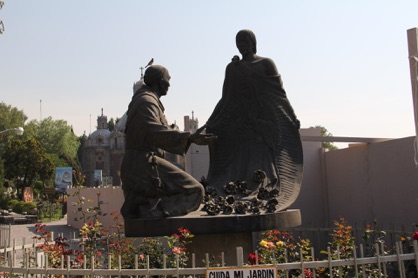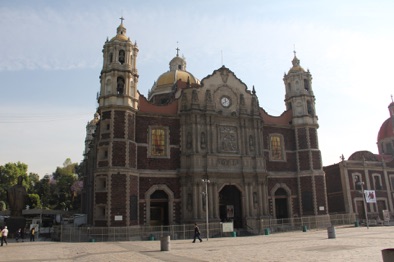Please don’t enter with balloons, the sign said as we walked into the Basilica of our Lady of Guadalupe. It was a strange juxtaposition to think of balloons and a church in the same thought. But to be honest, the entire story of la Virgen is a bit on the fantastical side.
Diego, understandably excited, rushed back to the local bishop and told him of the vision and the Virgin’s requirement. The Bishop didn’t believe Diego and asked for proof of the miracle.
Returning to the same spot, Juan Diego saw the Virgin again and related the requirements of the Bishop to her. She then filled Diego’s outstretched cloak with roses. Diego hurried back with the roses, a miraculous find for winter, and presented them to the Bishop.
Since the Virgin appeared as a native person, dark-skinned, there’s a love for her from the populace that can’t be overstated. We feel its affects even here. Anytime you see a lady in a green robe painted on a tailgate of a pickup, or go to Walmart buy candles, you’ll know what all the hubub is about. She is the representation of the common person of the Americas.
It’s a great story to be sure. But it doesn’t end there. Interestingly enough, there’s no mention of Juan Diego anywhere in any writings, including from the Bishop he supposedly gave the roses. One would think the days events in 1531 would warrant a word or two in one’s diary! But none exist.
Whatever you choose to believe, the site on which the supposed events occurred are a great place to visit. It’s still possible to see Juan Diego’s cloak and view the sacred image imprinted upon it.
Once again, there are times when you know you’re standing in front of history. This was one of those times. If there is a face for Latin America, she is it. We’ve grown up with that image, even though it wasn’t ours. So to see it in the flesh, so to speak, was, well, neat-o.
It was nearing noon by this time and we had a plane to catch. So we headed for the nearest Metro station. It was a good way to end the trip.
P.S. Every time I write one of these, I try to end with something that we learned. Of course this trip was extremely educational, historical, blah, blah, blah. But I have to say that my biggest learning experience, and the feeling that still haunts me, can be summed up in one word, poverty. Poverty on a scale I’ve never seen. Poverty on a scale I had tried to convince myself didn’t really exist. We’ve traveled in Mexico a bit, but nothing could’ve prepared us for what we saw in the City. Rarely did we enter a Metro station without being confronted with beggars, in worse states than I thought were humanly possible, without being in a hospital. Be very thankful for what you have.

















